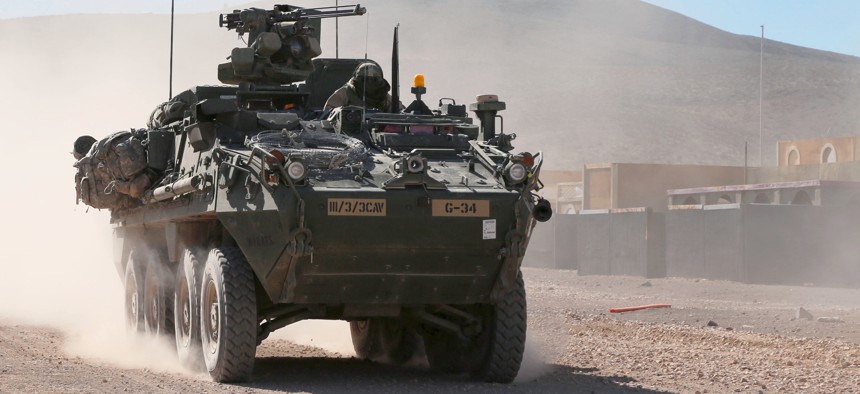
The General Dynamics Land Systems Stryker General Dynamics Land Systems
Tank Maker Teams Up With Remote-Control Car Company
General Dynamics and Kairos look to bridge the gap from here to autonomy.
What’s the fastest way to acquire unmanned ground vehicles? Rig your manned vehicles for remote control.
At least that’s the pitch from General Dynamics Land Systems. The maker of the Abrams tank and the Stryker armored fighting vehicle is teaming up with Kairos Autonomi, a company whose kits can turn virtually anything with wheels or tracks into a remote-controlled car. It’s part of a strategic play to meet the U.S. Army’s expanding demand for unmanned ground vehicles.
Kairos — the name comes from a Greek term meaning “opportune moment” — makes two types of kits. One is basically a seat robot that works a car’s controls just as a human would, and can be installed in about 20 minutes. The other leaves the seat free but takes several hours to install. No, it’s not autonomous driving — but it is here today and the military can put it on vehicles it already owns.
“You don’t have to go into the vehicle and pull the electronics out, pull out the architecture, cut the vehicle. You don’t have to start on a new build. It gives our military customers an option for a quick install and then they’ll have a remote or unmanned capability for existing vehicles,” said Phil Skuta, director of Marine programs at General Dynamics Land Systems, at the Association of the U.S. Army convention in Washington.
The military has already installed Kairos kits on disposable vehicles to create moving targets for shooting practice. But GDLS is now working to fit them onto heavier combat vehicles.. “We’ve had these installed on LAVs, on Strykers,” Skuta said.
The Army’s move to unmanned convoys and fighting machines is spelled out in its recent Autonomy and Robotic System Strategy, which lists semi-autonomous resupply (where trucks follow one another in a convoy) as a near-term goal and fully autonomous resupply a little later, around 2020. The eventual goal is full autonomy, but the route to that destination is unclear. Converting existing pieces of equipment into remotely driven fighting vehicles represents a step forward, one that’s achievable today at the cost of less than $30,000 per kit.
Related: U.S. Army Racing to Catch Up to Russia On Battle Drones
“Frankly, the technology in robotics is changing so rapidly, you can’t imagine someone building a thousand vehicles that are robots,” said Kairos founder Troy Takach, “because by the time they get the build started and the build ended, the technology will have eclipsed them.”
Takach says that the military’s fixation on achieving full autonomy has slowed progress toward deploy unmanned ground systems by pushing remote piloting efforts to the wayside.
“Everybody's trying to have autonomy,” he said. “That's what everybody considers the Holy Grail out there. That's why we don't have any robots deployed today, because if you go look at the military planning, the robots are always 20 years out.”
Indeed, the first self-driving car proof of concept arrived more than 10 years ago, in the 2005 DARPA Grand Challenge. The winning team from Stanford was quickly snatched up by Google, which has since managed to operationalize self-driving car technology funded by the military, and to do it faster than the military.
Lt. Gen. H.R. McMaster, who directs the U.S. Army’s Capabilities Integration Center, said getting remotely piloted and unmanned fighting vehicles out into the field is “something we really want to move forward on. What we want to do is get that kind of capability into soldiers’ hands early so we can refine the tactics, techniques and procedures, and then also consider enemy countermeasures and then build into the design of units that are autonomy enabled, build in the counter to those counters.”
Once soldiers can test and drill on unmanned vehicles, McMaster said, he’ll be looking to understand how well the vehicles perform when confronted with advanced electromagnetic and cyber weapons.
“The key is: how does it perform in a contested cyber [electronic warfare] environment. The mission assurance has to be under consideration from the beginning,” he said.
In this way, the integrity of data communication and transmission links is as important to as any breakthrough in autonomy or machine vision.
Skuta says that gives the United States a lead on Russia, which has said it will move to unmanned versions of the Armata T-14 tank.
“Our distinct advantage, with robotics in particular, is the coding and software because that’s what really makes the autonomy work; and the communications links, the ability to command and control, send data and communicate across a global network in a way that’s secure down to the point of tactical contact with the enemy. That’s a distinct advantage that we can protect.” he said.
Takach said rigging an Abrams tank for remote control would be more difficult than a standard automobile, but hardly impossible. General Dynamics was coy about the possibility. “We are looking at a competitive phase for programs coming out in 2017,” Skuta said.
NEXT STORY: UK Is Crowdsourcing Its Swarming Drone Attacks
